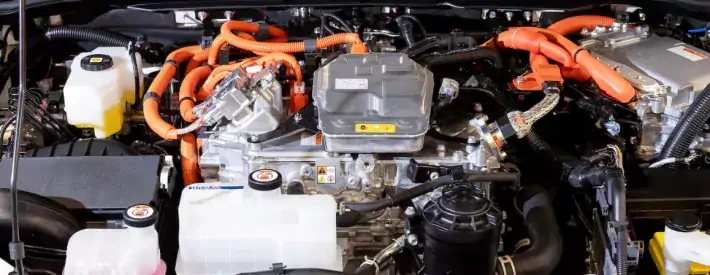Fuel face-off: what takes petrol and diesel's mantle?

Petrol and diesel pumps will slowly start to disappear over the next decade, but what’s the alternative to combustion fuel? We take a look at the three contenders…
Battery electric
With their roots dating back to Robert Davidson’s 1830s electric locomotive, battery electric vehicles (BEVs) use a rechargeable lithium-ion battery connected to at least one electric motor. In September 2023, the Society of Motor Manufacturers and Traders (SMMT) reported the 41st consecutive month of BEV sales increases and an impressive 18.9% year-on-year uplift. Bestsellers include the Teslas Y and 3, Kia’s e-Niro, VW’s ID.3 and the Nissan Leaf.
Leaving aside the question of who’s to blame for the lack of infrastructure, the UK government has committed £1.6bn to the mission, which equates to 300,000 new public chargers by 2030. According to charging map provider Zapmap, there are currently 50,000 points across the UK, up by 43% in just 12 months. Serious advances are also being made on recharging times, with BP claiming its new Pulse 150kW charger can deliver up to 100 miles-worth of juice in around 15 minutes.
Range anxiety is fading as more and more models deliver 300-plus miles on a full charge, while stunning battery advancements are announced almost daily. For instance, Mahle recently claimed a ‘leap forward’ in cooling plate technology, with 10% better cooling performance and 20% less pressure loss, all while saving 15% on materials. Toyota also announced that its next-generation solid-state packs could deliver a range of 621 miles with a fast charging time of 10 minutes or less to take the battery capacity from 10% to 80%. This all sounds very positive, so why isn’t everyone switching?
Well, purchase price is still an issue. The RAC offers the example of MG Motor UK’s ZS Hatchback, with the electric version being £8,000 more than its petrol equivalent, even when the plug-in grant existed. Attractive finance options may help soften this blow.
The picture gets even rosier when you look at running costs. Research by Compare the Market found an average saving of £600 per year for EVs over petrol cars, taking into account insurance, fuel and road tax. Some also suggest that fewer mechanical parts lead to lower service, maintenance and repair bills. Perhaps the only serious obstacle is the long waiting lists, with semiconductor supply chain problems making global headlines.
Biofuels
The biggest selling point of biofuels is the fact that they are derived from renewable sources. As with rechargeable batteries, experiments with biofuels began in the mid-19th century, using methanol or ethanol with potassium and sodium hydroxide as the catalyst.
Whether they realise it or not, millions of motorists use biofuels every day, with E10 unleaded petrol containing up to 10% bioethanol and B7 diesel up to 7% biodiesel. The bioethanol is made by fermenting crops such as corn and maize, while the biodiesel comes from vegetable oils combined with alcohol.
The main drawback of biofuels is that they still produce emissions when burned. The RAC also warned of E10 issues for up to 600,000 older vehicle owners. While most older vehicles would run on E5 fuel, doubling the amount of ethanol can cause a variety of issues in classic cars, from troublesome condensation in fuel lines to perished rubber hoses and seals.
However, the technology is improving. One of the second-generation biofuels, hydrotreated vegetable oil, can be used in many standard diesel engines and is endorsed by brands such as Caterpillar, Scania and Volvo.
In addition, bespoke fuel specialist Coryton recently launched the Sustain Classic range, which it says is “The UK’s first publicly available sustainable petrol”. The range includes three grades: Super 80, with at least 80% renewable content; Super 33, with at least a third renewable; and Racing 50, with at least 50% renewable. David Richardson, Business Development Director at Coryton, said: “We’re setting truthful and realistic goals, producing fuels that have a meaningful impact while meeting the demands of the user.”
At the very least, biofuels can be a highly effective bridging technology, with the Renewable Fuels Association in the US backing their wider adoption in both road transport and aviation.
Hydrogen
Finally, we come to that long-touted rival to BEV, hydrogen. This has the longest history of all, with Swiss inventor François Isaac de Rivaz patenting a hydrogen-powered internal combustion engine in 1807.
Again, vehicles running on hydrogen are already on our roads, albeit in small numbers. Toyota makes a great play of the fact that its hydrogen fuel cell electric vehicle Mirai emits only water vapour.
“We’re fully committed to fuel cell, particularly for larger vehicles because of the advantages in terms of range and refuelling time,” explained Katherine Chamberlain, Senior Manager for New Product Development at Toyota Motor Manufacturing UK. “But we’re also pursuing hybrid, plug-in hybrid, battery electric and hydrogen combustion, keeping all options open.”
In March, JCB unveiled a new hydrogen combustion engine designed specifically for heavy construction and agricultural equipment. Despite investing in battery electric for its smaller vehicles, the Staffordshire-based manufacturer needed a different solution for large machines working long shifts with little downtime available for recharging.
“The unique combustion properties of hydrogen enable the engine to deliver the same power, torque and efficiency that powers JCB machines today, but in a zero-carbon way,” said JCB Chairman, Anthony Bamford. “Hydrogen combustion engines also offer other significant benefits. By leveraging diesel engine technology and components, they do not require rare earth elements and, critically, combustion technology is already well proven.”
A major issue is that well over 90% of all hydrogen produced globally comes from natural gas, coal and oil, which isn’t exactly a sustainable way to produce the fuel. However, huge sums are being invested in industrial electrolysis – splitting water into hydrogen and oxygen – to overcome this thorny hurdle.
This is an edited extract from IMI's new MotorPro magazine, received free as part of IMI membership

